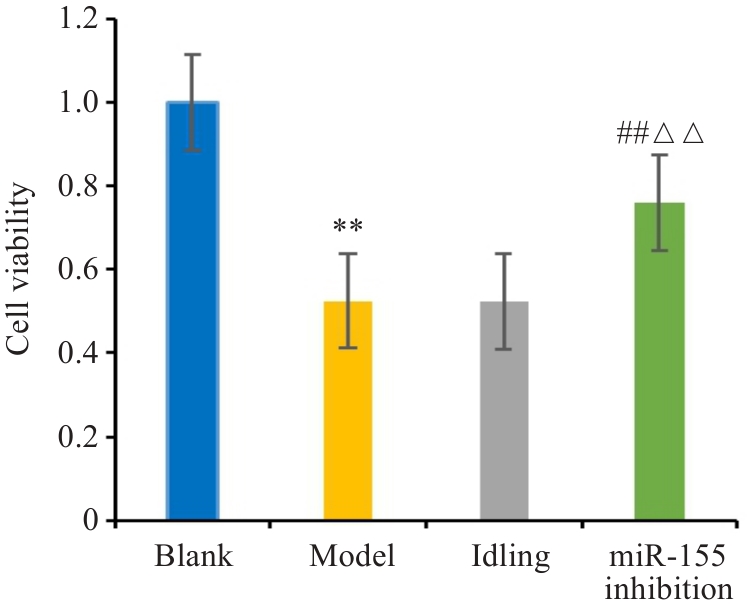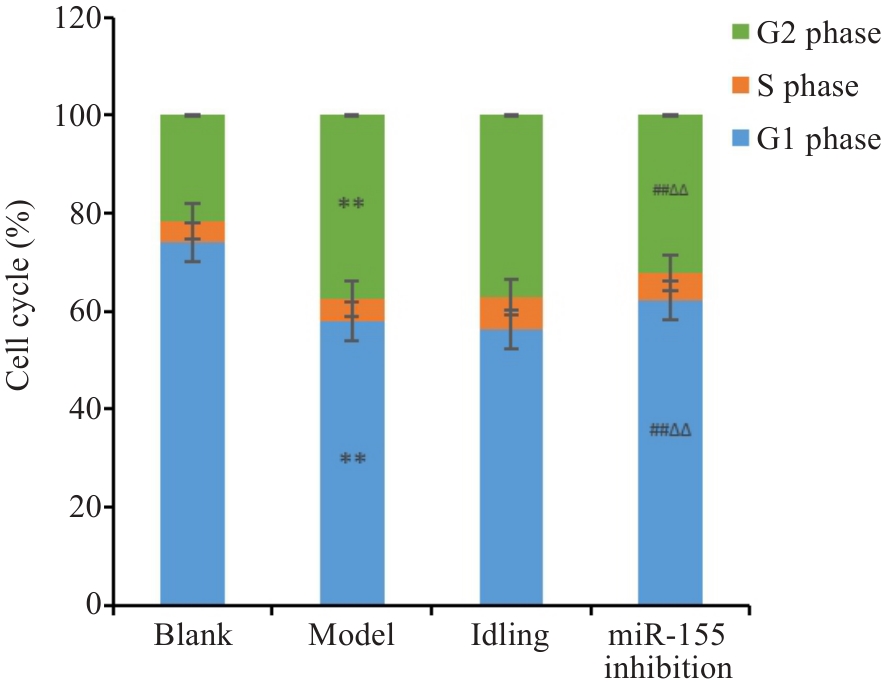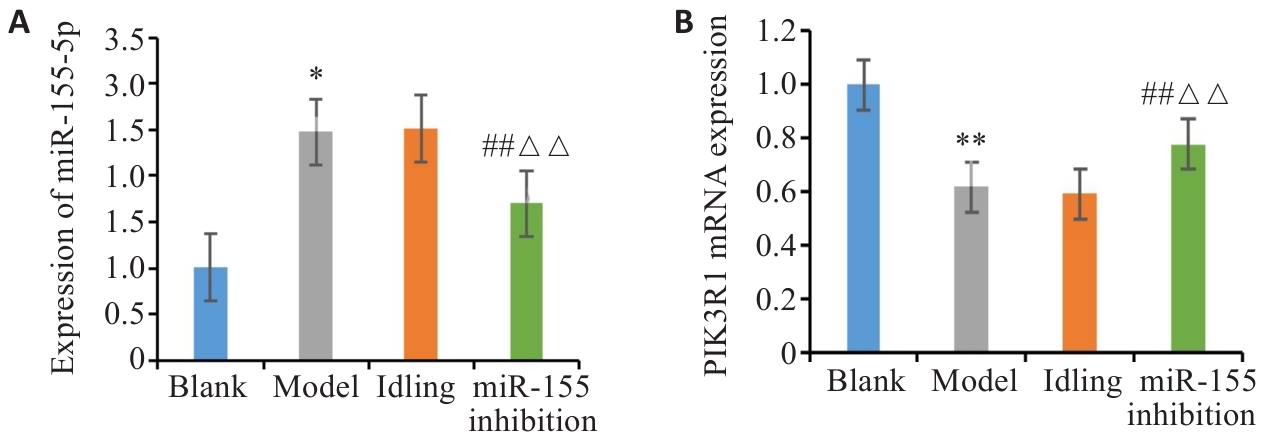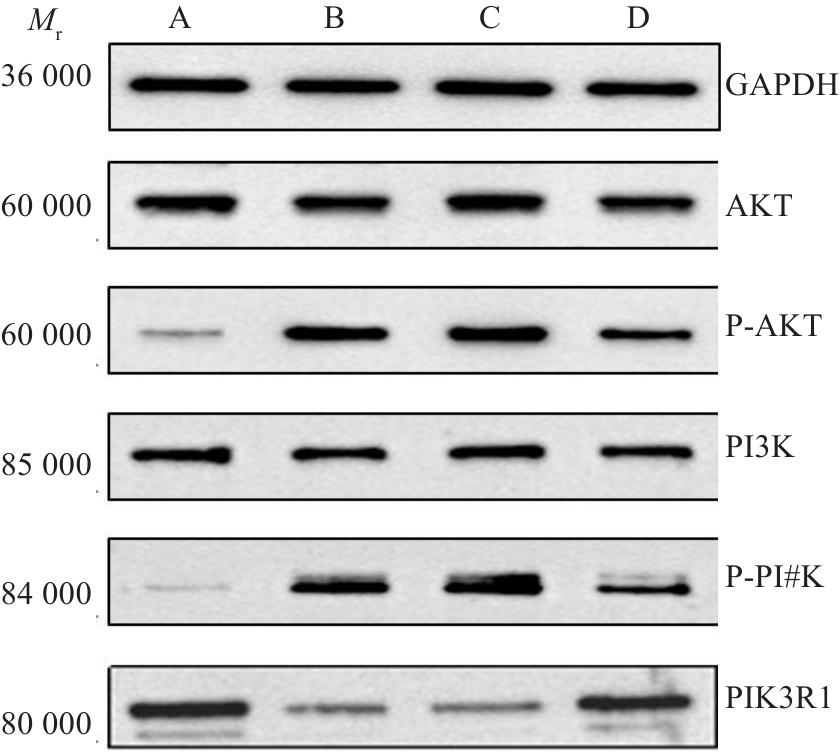Journal of Southern Medical University ›› 2025, Vol. 45 ›› Issue (1): 65-71.doi: 10.12122/j.issn.1673-4254.2025.01.09
Previous Articles Next Articles
Yuru ZHANG1( ), Lei WAN1,3,4(
), Lei WAN1,3,4( ), Haoxiang FANG2, Fangze LI1, Liwen WANG1, Kefei LI1, Peiwen YAN1, Hui JIANG1
), Haoxiang FANG2, Fangze LI1, Liwen WANG1, Kefei LI1, Peiwen YAN1, Hui JIANG1
Received:2024-09-20
Online:2025-01-20
Published:2025-01-20
Contact:
Lei WAN
E-mail:2693480130@qq.com;yxwanlei@163.com
Supported by:Yuru ZHANG, Lei WAN, Haoxiang FANG, Fangze LI, Liwen WANG, Kefei LI, Peiwen YAN, Hui JIANG. Inhibiting miR-155-5p promotes proliferation of human submandibular gland epithelial cells in primary Sjogren's syndrome by negatively regulating the PI3K/AKT signaling pathway via PIK3R1[J]. Journal of Southern Medical University, 2025, 45(1): 65-71.
Add to citation manager EndNote|Ris|BibTeX
URL: https://www.j-smu.com/EN/10.12122/j.issn.1673-4254.2025.01.09
| Item | Liquid A | Liquid B |
|---|---|---|
| Plasmid | 246 μL serum-free medium+4 μg plasmid | 240 μLserum-free medium+10 μL |
| DNA | DNA | Lipofectamine 2000 |
Tab.1 Ingredients of Liquid A and B
| Item | Liquid A | Liquid B |
|---|---|---|
| Plasmid | 246 μL serum-free medium+4 μg plasmid | 240 μLserum-free medium+10 μL |
| DNA | DNA | Lipofectamine 2000 |

Fig.2 Effect of miR-155 inhibitor on viability of HSGEC model of pSS (pSS-HSGECs). **P<0.01 vs Blank group; ##P<0.01 vs Model group; ΔΔP<0.01 vs Idling group.

Fig.4 Effect of miR-155p inhibitor on cell cycle distribution in pSS-HSGECs. **P<0.01 vs the blank group; ##P<0.01 vs the Model group; ΔΔP<0.01 vs the Idling group.

Fig.8 Expression of miR-155-5p and PIK3R1 mRNA in pSS-HSGECs in each group. **P<0.01 vs Blank group; ##P<0.01 vs Model group; ΔΔP<0.01 vs Idling group.

Fig.9 Protein expressions of the PI3K/AKT pathway in pSS-HSGECs in each group. A: Blank group. B: Model group. C: Idling group. D: miR-155 inhibition group.
| 1 | Longhino S, Chatzis LG, Dal Pozzolo R, et al. Sjögren's syndrome: one year in review 2023[J]. Clin Exp Rheumatol, 2023, 41(12): 2343-56. |
| 2 | Wei SJ, He QM, Zhang Q, et al. Traditional Chinese medicine is a useful and promising alternative strategy for treatment of Sjogren's syndrome: a review[J]. J Integr Med, 2021, 19(3): 191-202. |
| 3 | Xuan JX, Ji ZQ, Wang B, et al. Serological evidence for the association between epstein-barr virus infection and sjögren's syndrome[J]. Front Immunol, 2020, 11: 590444. |
| 4 | 任 渊, 崔戈丹, 高永翔. 原发性干燥综合征患者颌下腺炎症反应机制研究进展[J]. 浙江大学学报: 医学版, 2021, 50(6): 783-94. |
| 5 | Mavragani CP. Mechanisms and new strategies for primary sjögren's syndrome[J]. Annu Rev Med, 2017, 68: 331-43. |
| 6 | Wang-Renault SF, Boudaoud S, Nocturne G, et al. Deregulation of microRNA expression in purified T and B lymphocytes from patients with primary sjögren's syndrome[J]. Ann Rheum Dis, 2018, 77(1): 133-40. |
| 7 | Shan J, Jin H, Xu Y. T cell metabolism: a new perspective on Th17/treg cell imbalance in systemic lupus erythematosus[J]. Front Immunol, 2020, 11: 1027. |
| 8 | Guo XY, Dang WY, Li N, et al. PPAR‑α agonist fenofibrate ameliorates sjögren syndrome-like dacryoadenitis by modulating Th1/Th17 and Treg cell responses in NOD mice[J]. Invest Ophthalmol Vis Sci, 2022, 63(6): 12. |
| 9 | Mahesh G, Biswas R. MicroRNA-155: a master regulator of inflammation[J]. J Interferon Cytokine Res, 2019, 39(6): 321-30. |
| 10 | Yan JB, Luo MM, Chen ZY, et al. The function and role of the Th17/treg cell balance in inflammatory bowel disease[J]. J Immunol Res, 2020, 2020: 8813558. |
| 11 | 李 雪, 张云龙, 宋子毅, 等.中药通过PI3K/Akt信号通路干预肾间质纤维化的研究进展[J].中国药房, 2024, 35(14): 1795-800. |
| 12 | Wang JC, Hu KL, Cai XY, et al. Targeting PI3K/AKT signaling for treatment of idiopathic pulmonary fibrosis[J]. Acta Pharm Sin B, 2022, 12(1): 18-32. |
| 13 | Kapsogeorgou EK, Stergiou IE, Chatzis L, et al. The role of the Akt signaling pathway in sjögren's syndrome[J]. Mediterr J Rheumatol, 2023, 34(1): 113-6. |
| 14 | Zhang J, Zhang X, Shi XJ, et al. CXCL9, 10, 11/CXCR3 axis contributes to the progress of primary sjogren's syndrome by activating GRK2 to promote T lymphocyte migration[J]. Inflammation, 2023, 46(3): 1047-60. |
| 15 | Aiyegbusi O, McGregor L, McGeoch L, et al. Renal disease in primary sjögren's syndrome[J]. Rheumatol Ther, 2021, 8(1): 63-80. |
| 16 | Jung SW, Park EJ, Kim JS, et al. Renal tubular acidosis in patients with primary sjögren's syndrome[J]. Electrolyte Blood Press, 2017, 15(1): 17-22. |
| 17 | Ritter J, Chen YD, Stefanski AL, et al. Current and future treatment in primary sjögren's syndrome-A still challenging development[J]. Joint Bone Spine, 2022, 89(6): 105406. |
| 18 | Negrini S, Emmi G, Greco M, et al. Sjögren's syndrome: a systemic autoimmune disease[J]. Clin Exp Med, 2022, 22(1): 9-25. |
| 19 | Bjordal O, Norheim KB, Rødahl E, et al. Primary sjögren's syndrome and the eye[J]. Surv Ophthalmol, 2020, 65(2): 119-32. |
| 20 | 戴 敏, 刘 婷, 许潆月, 等.原发性干燥综合征抑郁的研究进展[J].安徽医药, 2024, 28(3): 436-40. |
| 21 | Ramos-Casals M, Brito-Zerón P, Bombardieri S, et al. EULAR recommendations for the management of sjögren's syndrome with topical and systemic therapies[J]. Ann Rheum Dis, 2020, 79(1): 3-18. |
| 22 | Manfrè V, Chatzis LG, Cafaro G, et al. Sjögren's syndrome: one year in review 2022[J]. Clin Exp Rheumatol, 2022, 40(12): 2211-24. |
| 23 | Bayraktar R, van Roosbroeck K. MiR-155 in cancer drug resistance and as target for miRNA-based therapeutics[J]. Cancer Metastasis Rev, 2018, 37(1): 33-44. |
| 24 | Zhang JL, Zhu LL, Shi H, et al. Protective effects of miR-155-5p silencing on IFN-γ-induced apoptosis and inflammation in salivary gland epithelial cells[J]. Exp Ther Med, 2021, 22(2): 882. |
| 25 | Zhu F, Li HR, Liu YJ, et al. MiR-155 antagomir protect against DSS-induced colitis in mice through regulating Th17/Treg cell balance by Jarid2/Wnt/β‑catenin[J]. Biomedecine Pharmacother, 2020, 126: 109909. |
| 26 | Li L, Shan WQ, Zhu HJ, et al. SJMHE1 peptide from Schistosoma japonicum inhibits asthma in mice by regulating Th17/treg cell balance via miR-155[J]. J Inflamm Res, 2021, 14: 5305-18. |
| 27 | Revathidevi S, Munirajan AK. Akt in cancer: mediator and more[J]. Semin Cancer Biol, 2019, 59: 80-91. |
| 28 | Fan ZY, Liu YH, Shi ZL, et al. MiR-155 promotes interleukin-1β-induced chondrocyte apoptosis and catabolic activity by targeting PIK3R1-mediated PI3K/Akt pathway[J]. J Cell Mol Med, 2020, 24(15): 8441-51. |
| 29 | Zheng SJ, Xiao LR, Liu Y, et al. DZNep inhibits H3K27me3 deposition and delays retinal degeneration in the rd1 mice[J]. Cell Death Dis, 2018, 9(3): 310. |
| 30 | Wang LY, Jiang PF, Li JZ, et al. Loss of miR-155 sensitizes FLT3-ITD+AML to chemotherapy and FLT3 inhibitors via glycolysis blocking by targeting PIK3R1[J]. J Cancer, 2023, 14(1): 99-113. |
| 31 | Uko NE, Güner OF, Matesic DF, et al. Akt pathway inhibitors[J]. Curr Top Med Chem, 2020, 20(10): 883-900. |
| 32 | Ahmad Z, Somanath PR. AKT isoforms in the immune response in cancer[J]. Curr Top Microbiol Immunol, 2022, 436: 349-66. |
| [1] | Haonan¹ XU, Fang³ ZHANG, Yuying² HUANG, Qisheng⁴ YAO, Yueqin⁴ GUAN, Hao CHEN. Thesium chinense Turcz. alleviates antibiotic-associated diarrhea in mice by modulating gut microbiota structure and regulating the EGFR/PI3K/Akt signaling pathway [J]. Journal of Southern Medical University, 2025, 45(2): 285-295. |
| [2] | Yuejiao PEI, Huimin LIU, Yu XIN, Bo LIU. High expression of miR-124 improves cognitive function of sleep-deprived rats by modulating the PI3K/AKT signaling pathway [J]. Journal of Southern Medical University, 2025, 45(2): 340-346. |
| [3] | Zhoufang CAO, Yuan WANG, Mengna WANG, Yue SUN, Feifei LIU. LINC00837/miR-671-5p/SERPINE2 functional axis promotes pathological processes of fibroblast-like synovial cells in rheumatoid arthritis [J]. Journal of Southern Medical University, 2025, 45(2): 371-378. |
| [4] | Xianheng ZHANG, Jian LIU, Qi HAN, Yiming CHEN, Xiang DING, Xiaolu CHEN. Huangqin Qingrechubi Capsule alleviates inflammation and uric acid and lipid metabolism imbalance in rats with gouty arthritis by inhibiting the PTEN/PI3K/AKT signaling pathway [J]. Journal of Southern Medical University, 2024, 44(8): 1450-1458. |
| [5] | Shan XIANG, Zongxing ZHANG, Lu JIANG, Daozhong LIU, Weiyi LI, Zhuoma BAO, Rui TIAN, Dan CHENG, Lin YUAN. Tujia medicine Toddalia asiatica improves synovial pannus in rats with collagen-induced arthritis through the PI3K/Akt signaling pathway [J]. Journal of Southern Medical University, 2024, 44(8): 1582-1588. |
| [6] | Yuanyuan WANG, Teng CHEN, Xiaofan CONG, Yiran LI, Rui CHEN, Pei ZHANG, Xiaojin SUN, Surong ZHAO. Pristimerin enhances cisplatin-induced apoptosis in nasopharyngeal carcinoma cells via ROS-mediated deactivation of the PI3K/AKT signaling pathway [J]. Journal of Southern Medical University, 2024, 44(5): 904-912. |
| [7] | GUO Jingjing, ZHANG Wenlong, LIANG Piao, ZHANG Longjun, PENG Lingyin, MIN Yuqi, PAN Xiaozhen, YANG Zhiying, DENG Huafei. Puerarin alleviates lipopolysaccharide-induced acute kidney injury in mice by modulating the SIRT1/NF-κB pathway [J]. Journal of Southern Medical University, 2023, 43(7): 1248-1253. |
| [8] | LI jingyi, YANG Siyuan, HAN Zhen, JIANG Tianle, ZHU Yao, ZHOU Zihang, ZHOU Jingping. Akt2 inhibitor promotes M2 macrophage polarization in rats with periapical inflammation by reducing miR-155-5p expression [J]. Journal of Southern Medical University, 2023, 43(4): 568-576. |
| [9] | GAO Xiaoyang, ZHAO Xiaolu, ZHANG Chunyan, YAN Yuxin, JIN Rong, MA Yuehong. Quercetin induces hepatic stellate cell apoptosis by inhibiting the PI3K/Akt signaling pathway via upregulating miR-146 [J]. Journal of Southern Medical University, 2023, 43(10): 1725-1733. |
| [10] | FAN Xiaoli, WANG Juan, WANG Liming. Licochalcone A induces cell cycle arrest in human lung squamous carcinoma cells via the PI3K/Akt signaling pathway [J]. Journal of Southern Medical University, 2023, 43(1): 111-116. |
| [11] | CHEN Xin, QI Xiuchun, CAO Yujing, LI Yang, LI Haoliang, WANG Qianjin, AI Jinwei. Indirubin relieves inflammatory injury of chondrocytes in a mouse model of osteoarthritis [J]. Journal of Southern Medical University, 2022, 42(9): 1381-1388. |
| [12] | LIANG Xiaofang, YANG Yue, XU Shuaishuai, LIU Ying, CHU Hanyu, TANG Yan, YANG Fei. Long-term low-dose microcystin-LR exposure induces renal injury in mice by activating PI3K/AKT signaling pathway [J]. Journal of Southern Medical University, 2022, 42(10): 1486-1494. |
| [13] | LIU Jianrong, SHEN Weixing, CHENG Haibo, FAN Minmin, XIAO Jun, XU Changliang, TAN Jiani, LAI Yueyang, YU Chengtao, SUN Dongdong, LI Liu. Shenbai Jiedu Fang inhibits AOM/DSS-induced colorectal adenoma formation and carcinogenesis in mice via miRNA-22-mediated regulation of the PTEN/PI3K/AKT signaling pathway [J]. Journal of Southern Medical University, 2022, 42(10): 1452-1461. |
| [14] | . PI3K/Akt signaling pathway mediates the protective effect of endomorphin-1 post-conditioning against myocardial ischemia-reperfusion injury in rats [J]. Journal of Southern Medical University, 2021, 41(6): 870-875. |
| [15] | . Alkaline processing of cantharidin can significanty improve the antitumor activity of cantharidin [J]. Journal of Southern Medical University, 2020, 40(09): 1332-1339. |
| Viewed | ||||||
|
Full text |
|
|||||
|
Abstract |
|
|||||